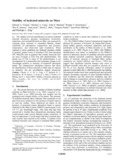| dc.contributor.author | Cloutis, Edward A. | |
| dc.contributor.author | Craig, Michael A. | |
| dc.contributor.author | Mustard, John F. | |
| dc.contributor.author | Kruzelecky, Roman V. | |
| dc.contributor.author | Jamroz, Wes R. | |
| dc.contributor.author | Scott, Alan | |
| dc.contributor.author | Bish, David L. | |
| dc.contributor.author | Poulet, François | |
| dc.contributor.author | Bibring, Jean-Pierre | |
| dc.contributor.author | King, Penelope L. | |
| dc.date.accessioned | 2018-03-07T15:00:05Z | |
| dc.date.available | 2018-03-07T15:00:05Z | |
| dc.date.issued | 2007-10-20 | |
| dc.identifier.citation | Cloutis, E.A., M.A. Craig, J.F. Mustard, R.V. Kruzelecky, W.R. Jamroz, A. Scott, D.L. Bish, F. Poulet, J.-P. Bibring, and P.L. King (2007) Stability of hydrated minerals on Mars. Geophysical Research Letters, 34, L20202. DOI:10.1029/2007GL031267. | en_US |
| dc.identifier.issn | 0094-8276 | |
| dc.identifier.uri | http://hdl.handle.net/10680/1391 | |
| dc.description.abstract | The validity of recent identification of various hydrated minerals (kieserite, gypsum, hexahydrite, nontronite, chamosite, and montmorillonite) on Mars was assessed by exposing these minerals to simulated Martian surface conditions of atmospheric composition and pressure, temperature, and ultraviolet light irradiation. When exposed to such conditions the hydrated minerals exhibit in general, greater losses of interlayer H2O than structural OH. Minerals such as gypsum that contain structural H2O are more resistant to H2O loss than phyllosilicates. The partial loss of OH in some of the phyllosilicates is not accompanied by a measurable and systematic change in the wavelength position or intensity of metal-OH absorption bands. The characteristic absorption features that allow for identification of these minerals on Mars may be reduced in intensity, but are nevertheless largely preserved. | |
| dc.description.sponsorship | This study was supported with grants from the University of Winnipeg, the Canadian Space Agency. Funding for our spectrometer and Mars environment chamber facility at the University of Winnipeg (HOSERLab) was provided by the Canada Foundation for Innovation, the Manitoba Research and Innovation Fund and the Canadian
Space Agency. | |
| dc.description.uri | https://agupubs.onlinelibrary.wiley.com/doi/abs/10.1029/2007GL031267 | |
| dc.language.iso | en | en_US |
| dc.publisher | Geophysical Research Letters | en_US |
| dc.rights | info:eu-repo/semantics/openAccess | |
| dc.title | Stability of hydrated minerals on Mars | en_US |
| dc.type | Article | en_US |
| dc.identifier.doi | 10.1029/2007GL031267 | |

